The Marathon City Bridge
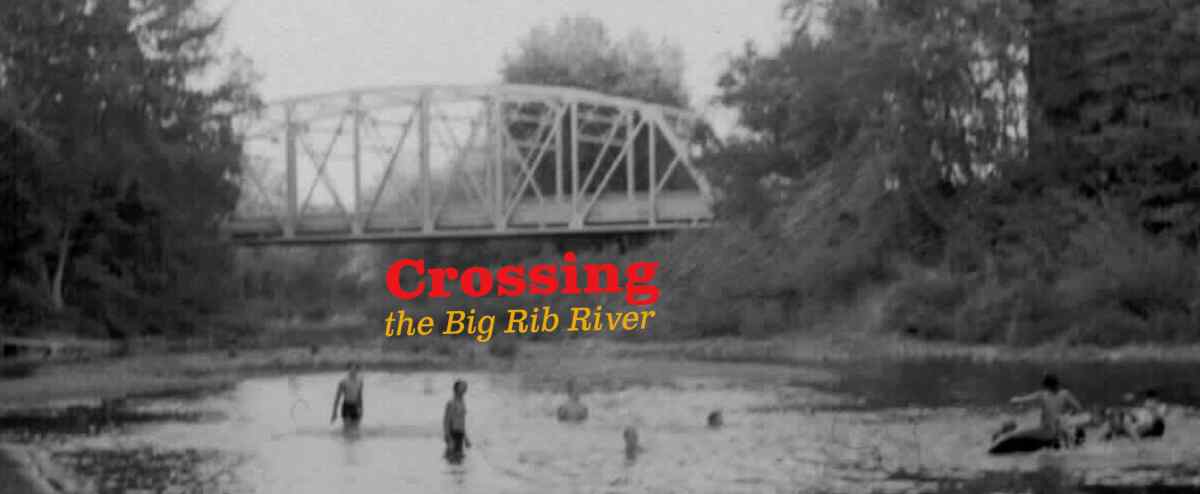
The Marathon City Bridge was built in 19301 to serve the main road into town on Highway 107 (then State Trunk 29) as it crossed the Big Rib River just outside the city and met up with Main Street. Prior to the 1930 bridge, the community had been served by one dating back to 1889 which was, for all intents and purposes, a wagon bridge.2 However, by the late 1920s, Marathon City boasted a population of approximately 750, and officials felt that a one-lane wagon bridge was no longer sufficient for the growing community.3
One of the few photos of the Marathon Wagon Bridge captured in a James Colby Photo Postcard
Image Credit: Marathon City Heritage Center
A Bridge Befitting a City
In 1928, the State Highway Commission began planning the construction of a new modern bridge for Marathon City.4 At 32 feet wide, not counting sidewalks, the new bridge would be more than double the width of its predecessor and capable of handling two lanes of traffic as well as a pedestrian walk.5 Construction and erection of the bridge were handled by Wausau Iron Works at a cost of approximately $110,000.6
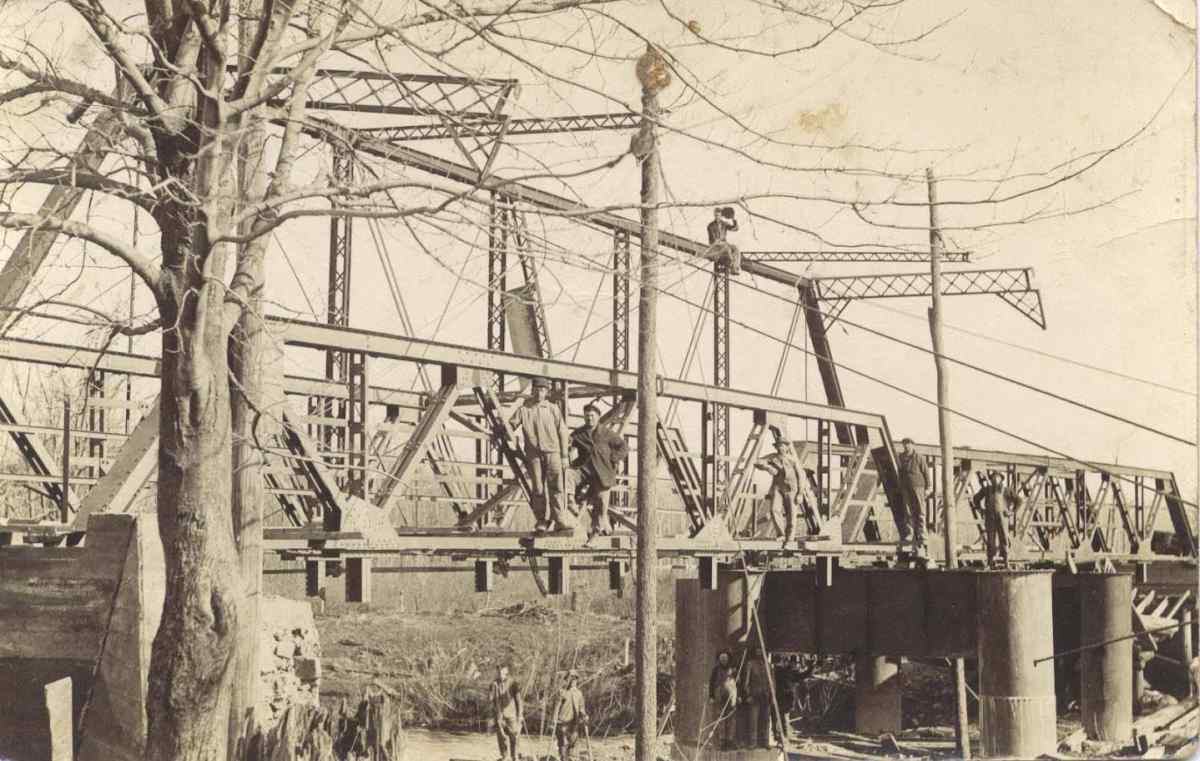
1930: The old Marathon City Bridge sits half demolished in the background as two of the girder spans for the new bridge go up in front of it.
Image Credit: Marathon City Heritage Center
Perhaps the bridge’s most striking feature was the manner in which it was constructed. Because of its location on the Rib River, the Marathon City Bridge had to cross two channels and a low-lying swampy island. To accomplish this the bridge was built in fifteen spans consisting of two 151-foot-long Parker overhead truss spans over the river channels separated by thirteen deck girder spans that crossed the island.7 The resulting bridge was not only extremely long for its locale but undeniably aesthetically pleasing as well, offering an impressive gateway to the community.
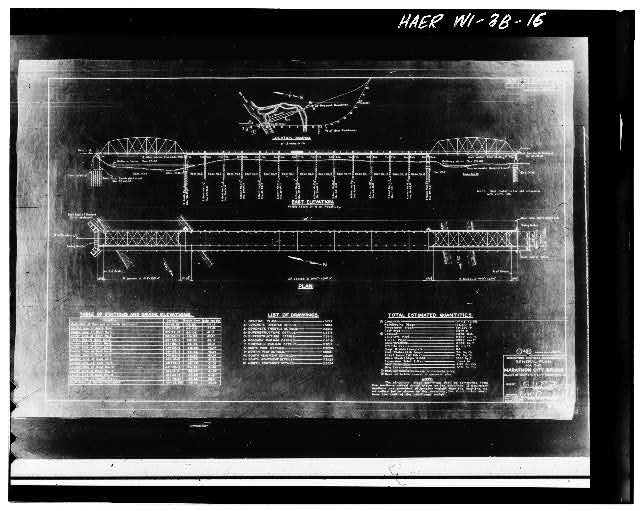
Out with the old and in with the new. The Wausau Ironworks Blueprints for the two truss and 13 girder spans that made up the 721 foot long bridge
Image Credit: Historic Engineering Database17
More than just a Bridge
The opening of the bridge was a big deal for Marathon City, and locals pulled out all the stops to celebrate its completion. Lifelong Marathon City Resident Fred Sicklinger recalled the spectacle in a 1989 interview with the Wausau Daily Herald.
It was painted with silver paint and it was
a great thing to look at...
At the completion of the bridge they had a
celebration. Some of the big politicians of the
county and the state and also the village were
there. They put on a pavement dance on the
bridge. Ribbons were cut and bands were
playing... and people enjoyed a big dance
that night.8
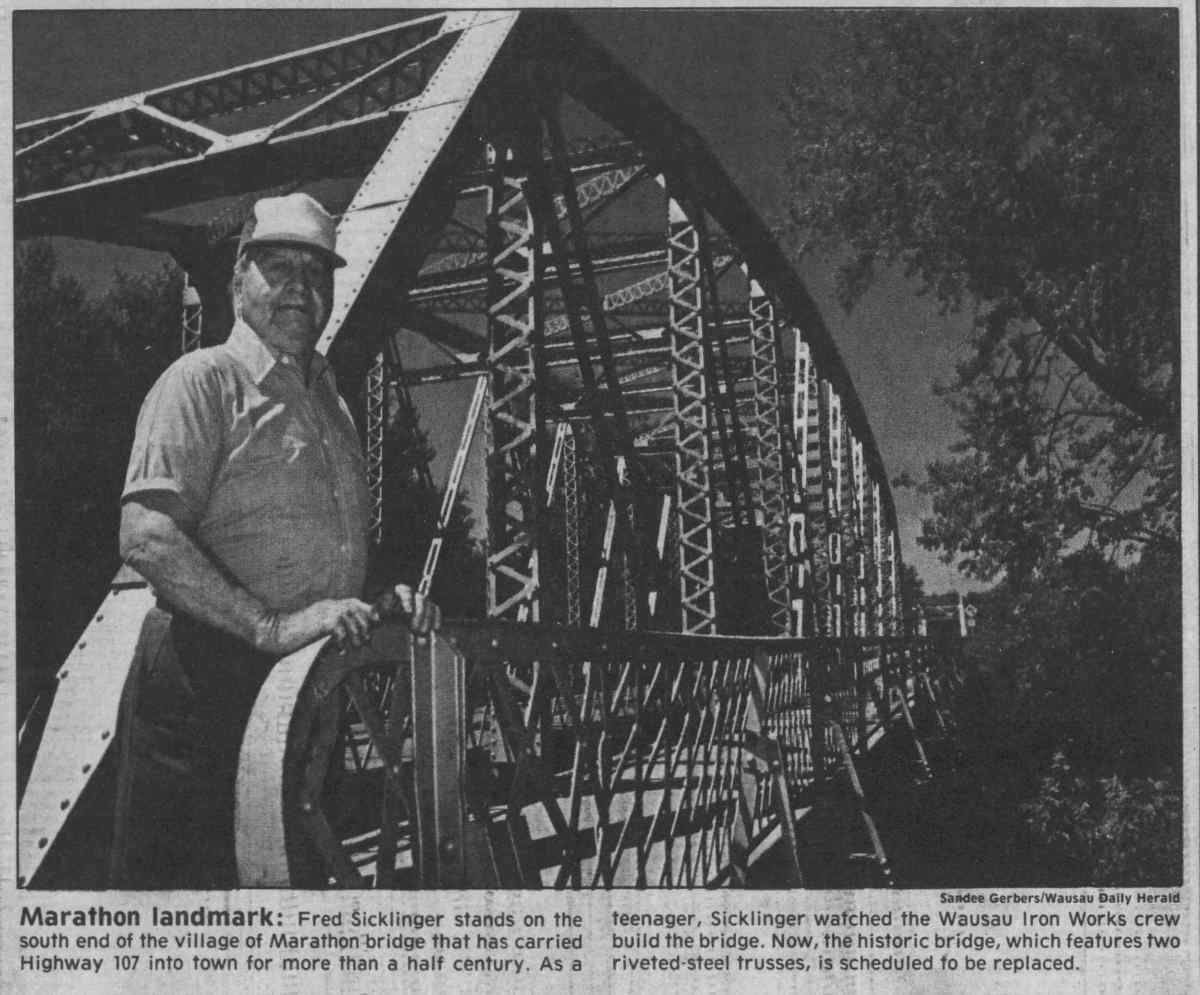
Image Credit: Sandee Gerbers Wausau Daily Herald June 14,1988
The Marathon City Bridge served the community faithfully for nearly 60 years, standing as a witness to the day to day activities of the community. “We used to stand up on the bridge and watch the muskellunge swimming in the river. There were some awful big muskellunge caught in the river in my time,” continued Sicklinger. 9
There were several times in my
day that I had to leave this part of the
country for work. And each time that
I would come home I would come
across the bridge.
It was a good feeling; it sort of
welcomed me home.10
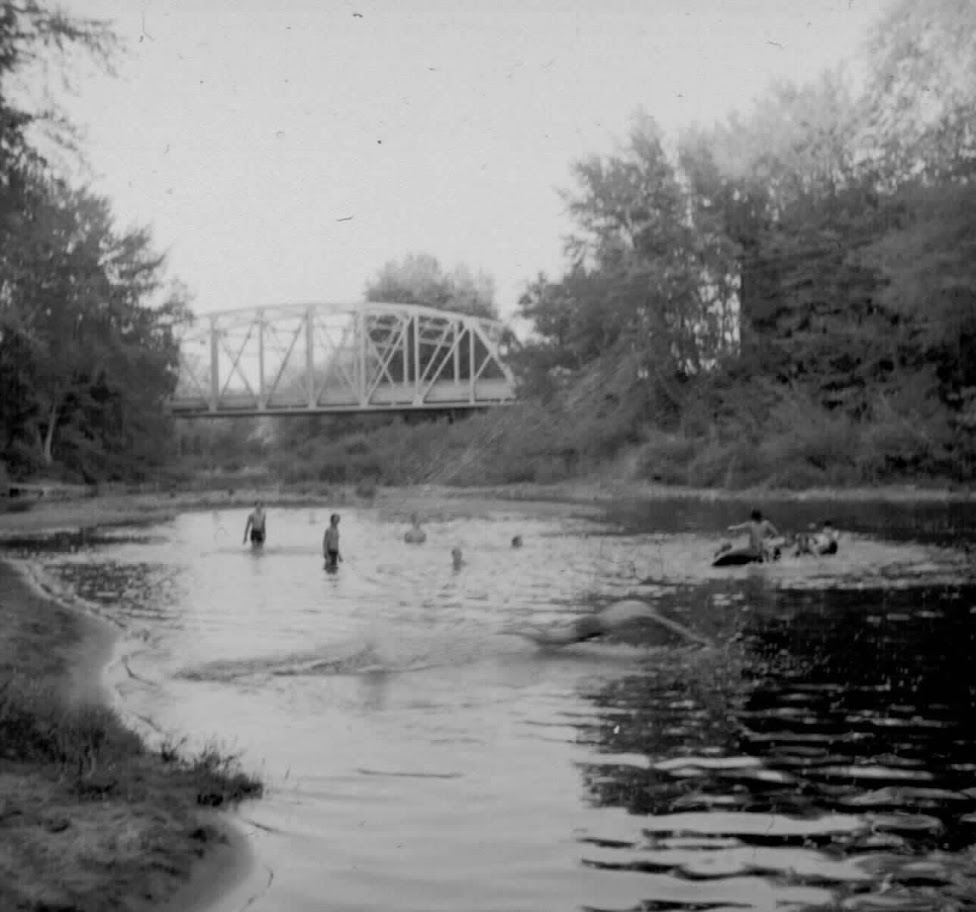
The Bridge was a constant presence in the community and a backdrop to the memories of many longtime residents.
Image Credit: Joe Straub
In the Name of Progress
Despite the sentimental value that the bridge held for many, by the 1980s it was straining to keep up with traffic demands. In at least two instances, large trucks struck the bridge’s overhead struts causing thousands of dollars of damage to themselves and the bridge.11 Modern farm machinery also struggled to fit across the aging bridge, something that was not acceptable in a rural community like Marathon.12 In 1988 the bridge was scheduled for replacement.13 Due to the historic nature of the bridge and the fact that it was eligible for the National Register of Historic Places, the DOT offered $139,000 to anyone willing to relocate and rehabilitate the bridge. Unfortunately, there were no takers.14 With no one willing to reuse the old bridge it was demolished in late spring of 1989. When asked if he would miss the old bridge Mr. Sicklinger replied, “Not really, I’m a guy who always looks at progress as a thing of life… When this bridge was built, it was something the town really needed. Now we need another new bridge.”15
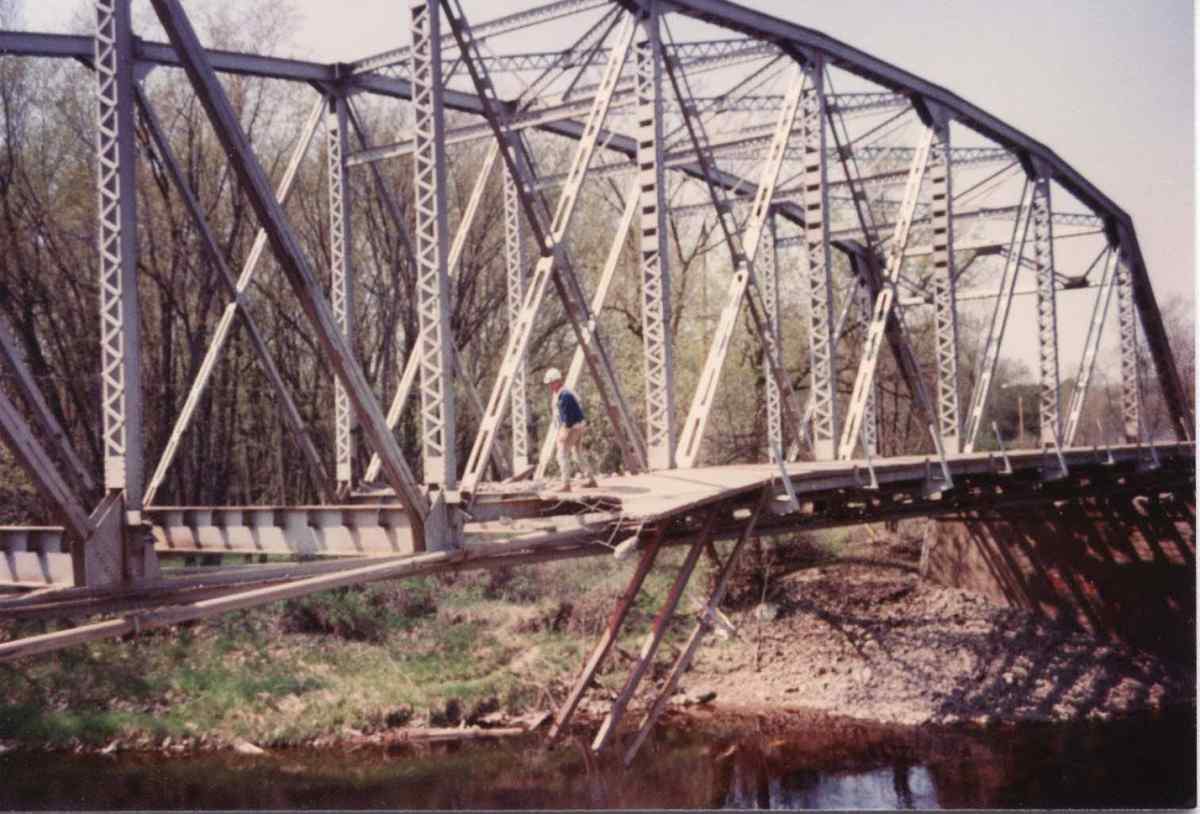
It's end of the line for the old Marathon City Bridge as workers strip away the road deck in preperation for demolition in Spring 1989.
Demolition was fast-tracked to avoid disrubting endangered swallows that nest along the river.
Image Credit: Joe Straub
A Bridge Befitting a MODERN City
The new bridge was dedicated on November 17, 1989. Unlike its predecessor there was no grand party or pavement dance held to mark its opening but, despite snowy conditions an official ribbon cutting was held ceremony was held. The guest of honor and ribbon cutter was Mildred Ruplinger, the bridge’s next-door neighbor and grandmother of village president Gary Ruplinger. Also on hand was the Marathon High School Band and the Marathon Fire Department who were given the honor of being the first to cross the new Marathon City Bridge.16 The loss of the old bridge was certainly unfortunate given its historic nature, but just as it had replaced a wagon bridge that could no longer handle the needs of the community, so too did it eventually find itself eventually outmoded. Presumably, sometime in the distant future, the current bridge too will eventually give way to a newer “better” replacement.
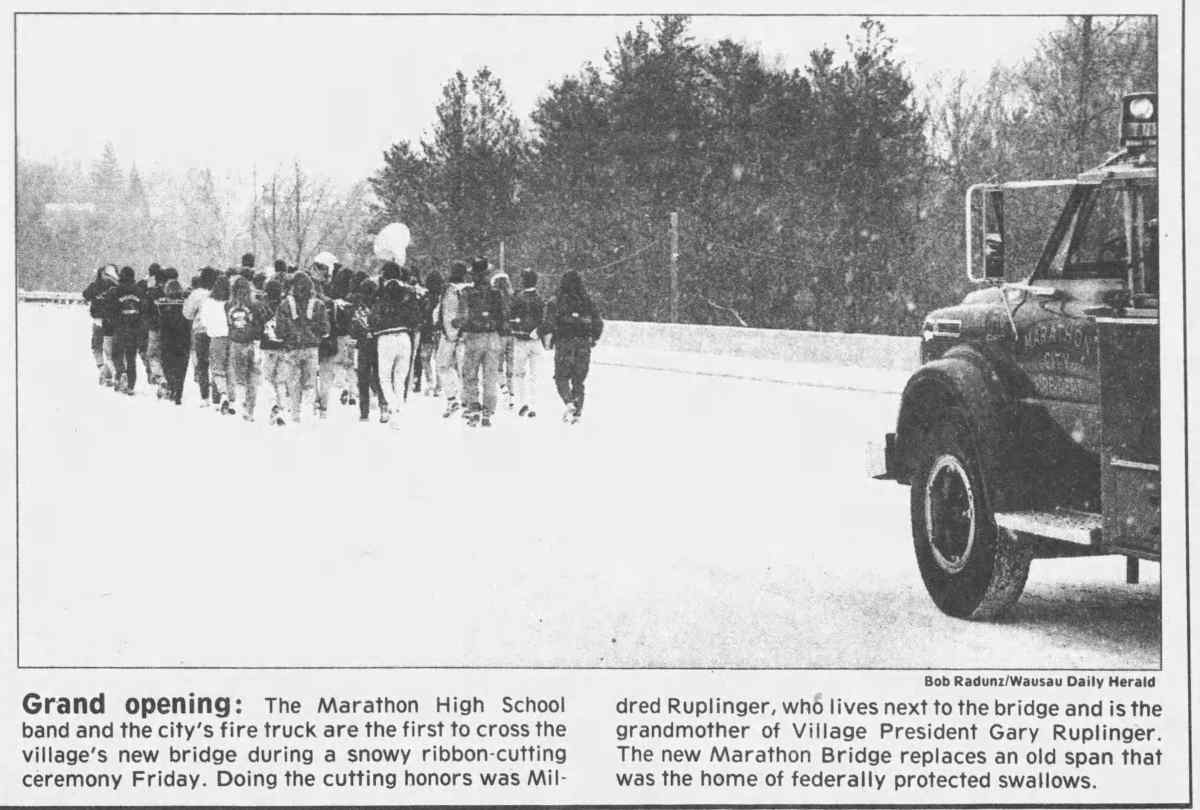
Image Credit: Bob Radunz Wausau Daily Herald November 18, 1989
< Previous Story Glossary Main Index Next Story >
1. U.S. Department of the Interior. Marathon City Bridge Photographs Written Historical And Descriptive Data. By Dian Krom and Robert Newbery. HAER no. WI-38. https://tile.loc.gov/storage-services/master/pnp/habshaer/wi/wi0200/wi0204/data/wi0204data.pdf (Accessed: June 2, 2023)
2. "Marathon City Bridge Photographs Written Historical And Descriptive Data"
3. "Marathon City Bridge Photographs Written Historical And Descriptive Data"
4. "Marathon City Bridge Photographs Written Historical And Descriptive Data"
5. "Marathon City Bridge Photographs Written Historical And Descriptive Data"
6. "Marathon City Bridge Photographs Written Historical And Descriptive Data"
7. "Marathon City Bridge Photographs Written Historical And Descriptive Data"
8. “Man vs. swallows” Wausau Daily Herald (Wausua), March 25, 1989.
9.“Man vs. swallows”
10.“Man vs. swallows”
11. “Marathon City Bridge Photographs Written Historical And Descriptive Data”
12. “In the name of Progress… Time’s up for Marathon’s silver bridge.” Wausau Daily Herald (Wausau), June 14, 1988.
13. “In the name of Progress"
14."“In the name of Progress"
15. “In the name of Progress"
16. “New Bridge.” Wausau Daily Herald (Wausau), November 18, 1989.
17. "Photocopy of original drawing, dated November 12, 1929, entitled 'General Plan of Marathon City Bridge,' Sheet 1 of 12 - Marathon City Bridge, Spanning Big Rib River, on state Trunk Highway 107, Marathon, Marathon County, WI", " Photograph, Historic American Engineering Record, National Park Service, U.S. Department of the Interior, 1987. From Prints and Photographs Division, Library of Congress HAER WIS,37-MARA,1--16 https://www.loc.gov/pictures/item/wi0204.photos.170337p/resource/ acces... 6, 2023).
